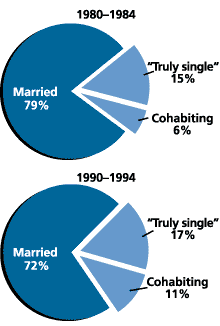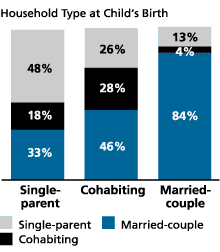
Increased Cohabitation Changing Children's Family Settings
(October 2002) Cohabitation is profoundly reshaping family life in the United States. The share of children born to parents who lived together but were not married nearly doubled between 1984 and 1994, growing from 6 percent to 11 percent. An even larger share of U.S. children — about 40 percent — will live with their unmarried mother and her boyfriend some time before their 16th birthday, according to a study supported by the National Institute of Child Health and Human Development (NICHD).
Researchers at the University of Wisconsin-Madison’s Center for Demography and Ecology surveyed recent cohabitation trends and analyzed their impact on the family life of children. Larry Bumpass and Hsien-Hen Lu used data from the National Survey of Families and Households (1987/1988) and the National Survey of Family Growth (1995), which collected detailed information on respondents’ fertility along with marriage and cohabitation histories through extended personal interviews.
Their findings point to growing instability in households with children even though divorce rates have stabilized over the last two decades. Cohabitation before, after, or instead of marriage has become more widespread, so more children are seeing their households reconfigured several times. But because their parents were not married to the partners they lived with, the children’s potentially divorce-like experiences are not reflected in national statistics.
Unmarried Childbearing
The researchers find that the large increase in unmarried childbearing between the first half of the 1980s and the first half of the 1990s was mainly the result of births to cohabiting parents. During that period, births to cohabiting mothers increased from 6 percent to 11 percent of all births, while the proportion of births to “truly single” mothers — not married or cohabiting — increased only slightly, from 15 percent to 17 percent (see Figure 1). Therefore, about two out of five babies born out of wedlock went home to two biological parents.
Figure 1
U.S. Births, by Mother’s Living Situation, 1980-1984 and 1990-1994

Sources: National Survey of Families and Households (1987/88) and the National Survey of Family Growth (1995).
Family Structure
The researchers estimate that about 40 percent of all children will spend some time in a cohabiting family before their 16th birthday. For children born to single mothers, the proportion likely to see their parent move in with an unmarried partner is 76 percent; for children born to married parents, the proportion is 20 percent.
How much time children will spend living with cohabiting parents, measured in share of childhood years, also depends on the type of household into which children are born. For all U.S. children, the share of childhood years spent living with cohabiting parents rose from 7 percent in 1988 to 9 percent in 1995, a 29 percent increase.
Children born to truly single mothers are likely to spend about half their childhood in a single-parent family, almost one-fifth of their childhood with a cohabiting parent, and about one-third with married parents (see Figure 2).
Figure 2
Expected Share of Childhood Years Spent in Various Household Types, by Household Type at Child’s Birth, 1990-1994

Note: Share of childhood years, U.S. children ages 0-16 (shares doe not add to 100 due to rounding).
Source: National Survey of Families and Households (1987/88) and the National Survey of Family Growth (1995).
Children born to cohabiting parents are likely to spend about one-quarter of their childhood with a single parent, about the same with cohabiting parents, and about half their time with married parents. Children born to married parents are likely to spend the greatest part of their childhood (84 percent) in a two-parent family, even though about one in three will experience divorce.
These findings underscore the importance of considering cohabitation when examining the family structure of children. Children born to cohabiting mothers, like those born to single mothers, typically spend less than half their childhood in married families (46 percent, compared with 33 percent for single-parent children). Yet, if the time they spend in cohabiting families is included, their experience resembles that of children in married families (74 percent of their childhood in a two-adult household, compared with 84 percent for children born to married parents). One-third of the time children spend in technically single-parent households is actually spent with their mother and her boyfriend, who may be the child’s father.
Researchers are just beginning to examine how these differences affect children’s lives and well-being. Not only do these trends have implications for the lives of children today, but they may influence the attitudes and values of the next generation. The researchers note that parents who cohabit may find it difficult to argue effectively that their children should abstain from unmarried sex or cohabitation, leading to even more widespread acceptance and practice of cohabitation in the future.
Paola Scommegna is a freelance writer.
For More Information
This article is excerpted from an NICHD briefing paper. For the full text, visit the NICHD website: www.nichd.nih.gov/about/cpr/dbs/pubs.htm.
